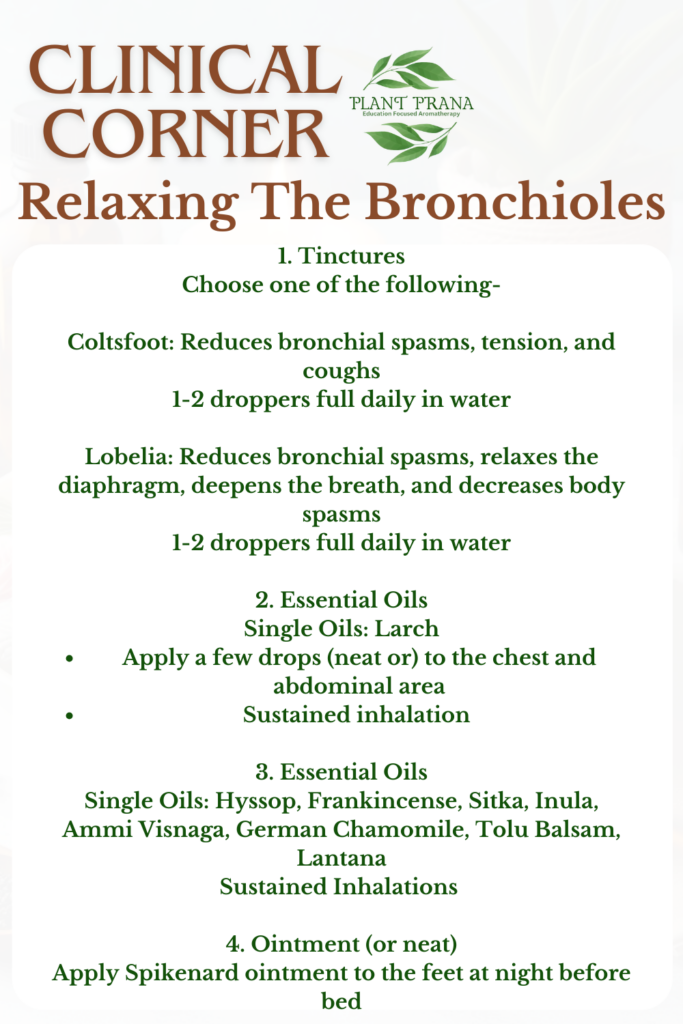Your cart is currently empty!
Want to know more...
Sign up for oil and class updates.
Relaxing The Bronchioles:

Relaxing the bronchioles — the small air passages in the lungs — has significant benefits, especially for respiratory health and overall oxygenation. The bronchioles are lined with smooth muscle, and when these muscles are relaxed, airflow improves, allowing for easier breathing and better lung function.
1. Improved Breathing & Oxygen Intake
Wider bronchioles allow more air to reach the alveoli (air sacs), improving oxygen exchange and reducing shortness of breath.
Supports better cellular respiration and energy production throughout the body.
2. Relief from bronchial constriction
Reduces the tightness and restriction seen in:
Asthma
Chronic bronchitis
COPD (Chronic Obstructive Pulmonary Disease)
Allergic reactions
Helps prevent or ease asthma attacks and bronchospasms.
3. Decreased Wheezing & Coughing
Relaxing the bronchioles relieves spasmodic coughing and wheezing, especially in conditions with airway constriction.
Leads to quieter, more effortless breathing.
4. Better Sleep & Reduced Fatigue
Easier breathing at night improves sleep quality, especially for those with nighttime asthma or sleep apnea.
Enhanced oxygenation reduces daytime fatigue and improves mental clarity.
5. Reduced Inflammation & Airway Stress
Relaxation of bronchial muscles can interrupt the cycle of inflammation, spasm, and mucus production.
Supports long-term healing and reduces the risk of chronic airway remodeling in conditions like asthma.
6. Enhanced Athletic Performance & Recovery
Athletes benefit from relaxed bronchioles through:
Improved ventilation efficiency
Reduced breathlessness during exertion
Faster recovery post-exercise
7. Support During Respiratory Infections
In conditions like colds, flu, or pneumonia, relaxing the bronchioles helps clear mucus and reduce discomfort.
Aids in restoring normal breathing patterns during illness.
8. Ripple Effect
Relaxing the bronchioles has a ripple effect across multiple body systems—especially through its influence on oxygenation, the nervous system, and inflammatory responses. While the bronchioles are part of the respiratory system, their relaxation can indirectly affect pain perception, anxiety, inflammation, adrenal function, and cognitive performance. One of the first steps for treating sharp stabbing pain is to reduce bronchial spasms which significantly reduces pain.
Summary of Effects by System
| System/Function | Effect of Bronchiolar Relaxation |
| Pain | Decreases tissue tension and hypoxia-related pain; calms sensory nerves |
| Anxiety | Promotes parasympathetic calm; improves breath control and reduces panic cycles |
| Inflammation | Enhances oxygenation and vagal tone; reduces systemic inflammatory responses |
| Adrenal Function | Reduces stress hormone output; supports HPA axis regulation and adrenal recovery |
| Cognitive Function | Improves oxygen to the brain; reduces neural overactivity and enhances focus, memory, and clarity |
Relaxation of Bronchioles:
1. Tinctures
Choose one of the following-
Coltsfoot: Reduces bronchial spasms, tension, and coughs
1-2 droppers full orally daily in water
Lobelia: Reduces bronchial spasms, relaxes the diaphragm, deepens the breath, and decreases body spasms
1-2 droppers full orally daily in water
2. Essential Oils
Single Oils: Larch
3. Essential Oils
Single Oils: Hyssop, Frankincense, Sitka, Inula, Ammi Visnaga, German Chamomile, Tolu Balsam, Lantana
Sustained Inhalations
4. Ointment (or neat)
Apply Spikenard ointment to the feet at night before bed